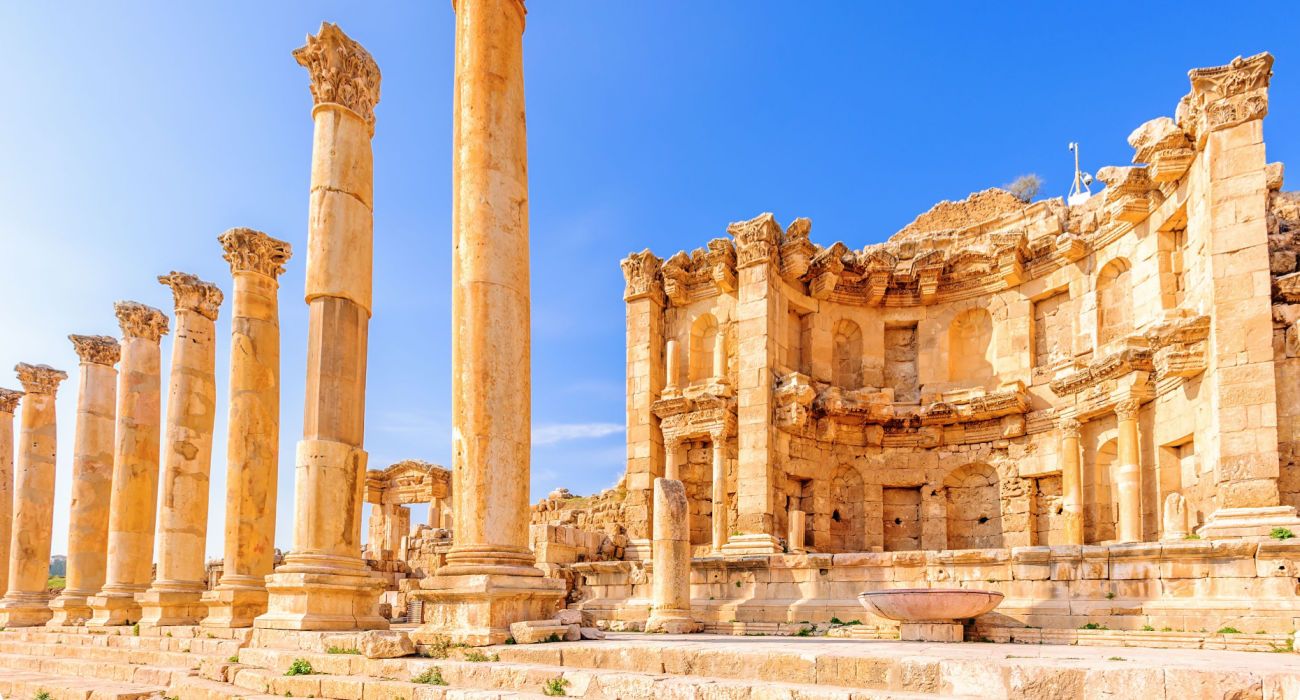Quick Links
Jordan is a remarkable country and is one of the safest and most visitor-friendly countries in the Middle East. The kingdom is internationally famous for Petra - said to be one of the Seven Wonders of the Modern World. But it also has a rich Roman history with some impressive Roman ruins to see and discover as well.
Today there are many Roman ruins across Jordan - many of which are well-preserved. Before the Romans arrived, Jordan was ruled by the Nabataean Kingdom, which was nomadic Arabs of the region. They set up their kingdom in 169 BC, and they controlled the lucrative trade routes of the region.
History Of Roman Jordan
The Nabatean kingdom stretched from the Red Sea up to as far as Damascus for a short time. The fortune the Nabataeans amassed enabled them to build their stunning capital Petra. It is believed to have been a mausoleum of the Arab Nabataean King Aretas IV.
Roman rule began in 63 BC under the famous Roman general Pompey. He conquered what is today Jordan as well as what is today Syria, Israel, and Palestine. The Romans conquered ten well-connected towns that formed part of the Decapolis League. These were ten towns that transformed into prosperous cities in which the Romans built many temples, theaters, palaces, and more.
In 106 AD, Emperor Trajan formally annexed Nabataea unopposed into the Empire and rebuilt the King's Highway (that later became known as the Via Traiana Nova road). The Romans then ruled Jordan for an impressive four centuries.
Under Roman rule, the ten cities of the Decapolis enjoyed a level of autonomy (seven of these ten cities are located in modern Jordan).
Discover The Limes Arabicus
On the frontiers of the empire, the Romans built Limes - or a series of fortifications to defend their empire. Today visitors to Germany can visit the Limes Germanicus - one of the most heavily defended frontiers of the Roman Empire.
On the other side of their empire, the Limes Arabicus ran through what is today Jordan. It was the desert frontier of the empire that started on the Gulf of Aqaba and range 1,500 kilometers or 930 miles up into northern Syria. The Limes Arabicus included forts and watchtowers - the remains of some of which can still be seen today.
Next to the Limes was the major road, the Via Nova Traiana, that extended some 430 kilometers or 270 miles.
Jerash: The Best Preserved City Of The Decapolis
Jerash was one of the cities of the Decapolis League and is today one of the top three Roman sites in Jordan. Jerash is famous for its preservation and restoration of prominent Roman structures. People come in awe of the many plazas, temples, and fountains of the ancient city.
One of the great attractions at Jerash is Hadrian's Arch, built in 129 AD to greet Emperor Hadrian when he visited.
- Entry Fee: 10 JD (USD $15)
Other places to explore include the remains of the Hippodrome, theaters (one of which is still used for concerts), the Forum and its 56 pillars, and the Jerash Archaeological Museum.
Amman Citadel In The Jordan Capital
Another place to visit is right in the modern Jordanian city of Amman. There, visitors can find the Amman Citadel with its many ruins. One of the main attractions in the citadel is the Roman Temple of Hercules and the hand that is believed to be the hand of a large Roman statue of Hercules (it is all that remains of the statue).
- Entry Fee: 2 JD (USD $2.80)
The citadel is open 8 am to 7 pm Saturday through Thursday between April and September. Between October and March, it is open until 4 pm. On Fridays all through the year, it is only open from 10 am to 4 pm.
Pella: A Massive City Of The Decapolis League
The other of the three main sites in Jordan for Roman ruins is Pella. Here visitors can see what was once a striking city dating back over 6,000 years. It, too, was one of the cities of the Decapolis League.
- Entry Fee: 2 JD (USD $3)
Note that there is a lot of walking in Pella to grasp the sheer size of the city. See the ancient Roman ruins like a theater, Roman baths, and a fountain house.
Roman ruins are to be found all over the Mediterranean; southern France has one of the best-preserved Roman aqueducts, while Tunisia has one of the best-preserved Roman Colosseums.

